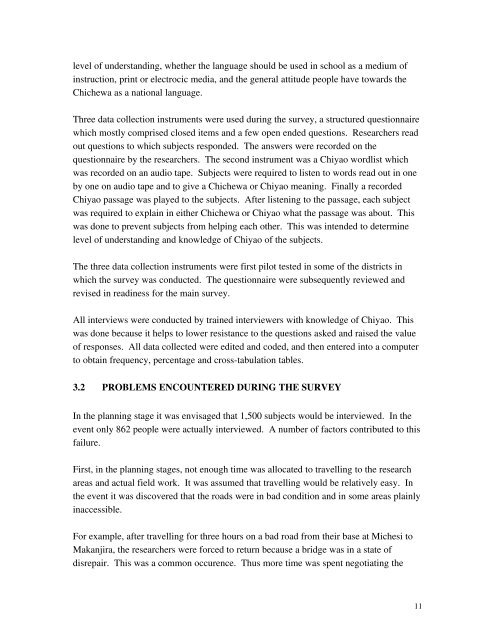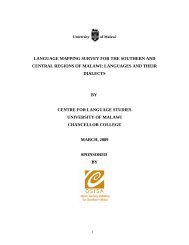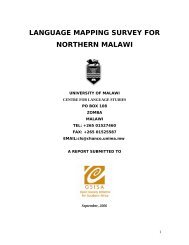SOCIOLOLINGUISTIC SURVEYS - Centre for Language Studies
SOCIOLOLINGUISTIC SURVEYS - Centre for Language Studies
SOCIOLOLINGUISTIC SURVEYS - Centre for Language Studies
Create successful ePaper yourself
Turn your PDF publications into a flip-book with our unique Google optimized e-Paper software.
level of understanding, whether the language should be used in school as a medium of<br />
instruction, print or electrocic media, and the general attitude people have towards the<br />
Chichewa as a national language.<br />
Three data collection instruments were used during the survey, a structured questionnaire<br />
which mostly comprised closed items and a few open ended questions. Researchers read<br />
out questions to which subjects responded. The answers were recorded on the<br />
questionnaire by the researchers. The second instrument was a Chiyao wordlist which<br />
was recorded on an audio tape. Subjects were required to listen to words read out in one<br />
by one on audio tape and to give a Chichewa or Chiyao meaning. Finally a recorded<br />
Chiyao passage was played to the subjects. After listening to the passage, each subject<br />
was required to explain in either Chichewa or Chiyao what the passage was about. This<br />
was done to prevent subjects from helping each other. This was intended to determine<br />
level of understanding and knowledge of Chiyao of the subjects.<br />
The three data collection instruments were first pilot tested in some of the districts in<br />
which the survey was conducted. The questionnaire were subsequently reviewed and<br />
revised in readiness <strong>for</strong> the main survey.<br />
All interviews were conducted by trained interviewers with knowledge of Chiyao. This<br />
was done because it helps to lower resistance to the questions asked and raised the value<br />
of responses. All data collected were edited and coded, and then entered into a computer<br />
to obtain frequency, percentage and crosstabulation tables.<br />
3.2 PROBLEMS ENCOUNTERED DURING THE SURVEY<br />
In the planning stage it was envisaged that 1,500 subjects would be interviewed. In the<br />
event only 862 people were actually interviewed. A number of factors contributed to this<br />
failure.<br />
First, in the planning stages, not enough time was allocated to travelling to the research<br />
areas and actual field work. It was assumed that travelling would be relatively easy. In<br />
the event it was discovered that the roads were in bad condition and in some areas plainly<br />
inaccessible.<br />
For example, after travelling <strong>for</strong> three hours on a bad road from their base at Michesi to<br />
Makanjira, the researchers were <strong>for</strong>ced to return because a bridge was in a state of<br />
disrepair. This was a common occurence. Thus more time was spent negotiating the<br />
11





